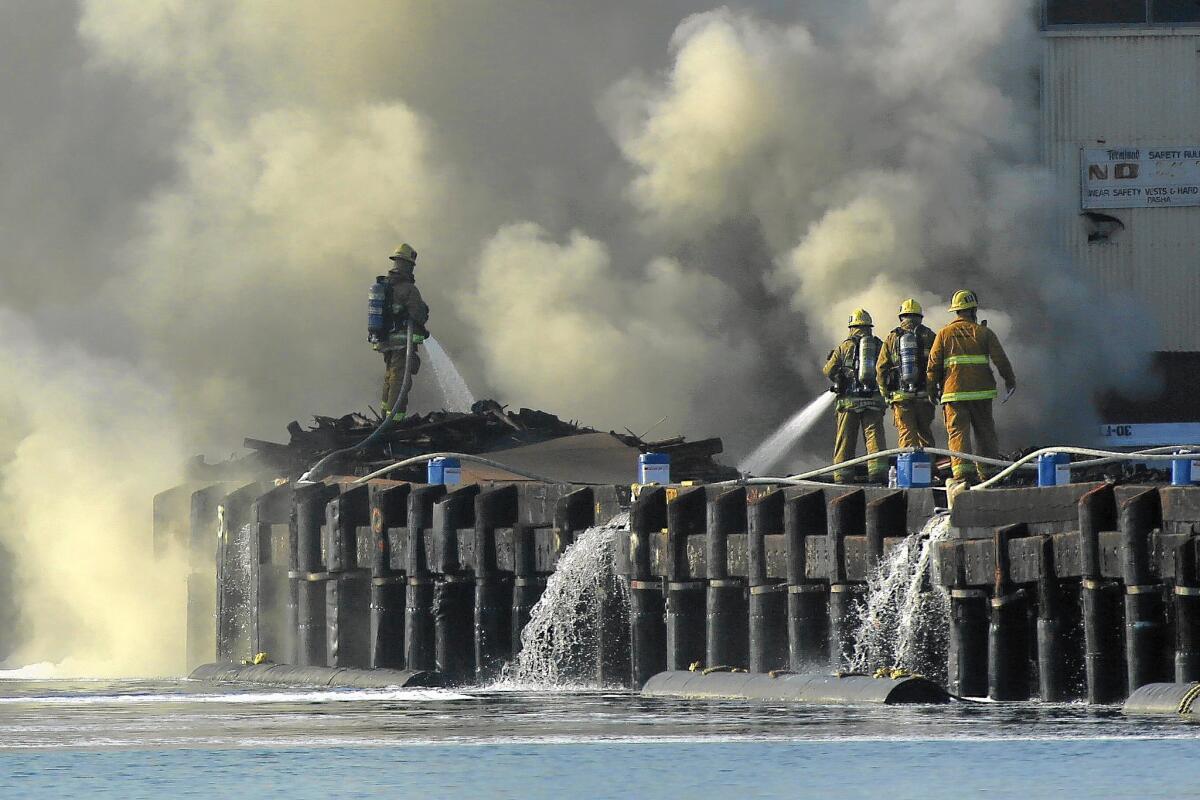Extensive harbor cleanup begins after Port of L.A. fire

- Share via
Port of Los Angeles authorities are beginning an extensive harbor cleanup in the aftermath of a fire that burned through much of a wharf and released toxic gases and smoke into surrounding communities.
The largest fire at the port in decades erupted Monday night, devouring 800 feet of a 1920s-era wharf and damaging a warehouse. It burned and smoldered through Tuesday before firefighters declared it extinguished Wednesday afternoon.
The blaze left behind a tremendous amount of charred wood from the wharf that broke off during the fire, port officials said, and it will take weeks to clean. The extent of the impact from chemicals that the fire released into the air, however, is less certain.
Wood fragments, ranging in size from popcorn kernels to 10 feet in length, were dispersed by the tide and are scattered throughout much of the harbor.
“It will be weeks before we get the bulk of this wood debris out of the harbor,” said Mike Christensen, deputy executive director of development for the Port of Los Angeles.
Boats are scooping up the burned wood and monitoring for material that could pose a navigational hazard. But Christensen said no lasting environmental damage is expected from the fire, and water quality in the harbor is good.
Because the fire ate through highly flammable, creosote-treated timbers, it posed difficulties for firefighters, prompted air quality advisories for two dozen cities in Los Angeles and Orange counties and led to school evacuations in adjacent Wilmington.
Air quality officials said the blaze generated levels of smoke that might typically be seen near a large wildfire. It also emitted naphthalene and benzene, chemicals released by the treated wood.
Naphthalene, a compound found in the coal tar used in creosote, was detected at unusually high levels at the fire and in the surrounding community, South Coast Air Quality Management District officials said.
The agency sent a portable air quality monitoring instrument into a smoldering warehouse with a firefighter. Levels of naphthalene were so high the device could not read them, “but were definitely over 100 [parts per billion],” according to a five-page report released after the fire.
At 10:30 a.m. Tuesday, the compound was measured at 50 parts per billion about a mile from the blaze at De La Torre Jr. Elementary School in Wilmington, where students were evacuated because of the smoke and fumes.
It remains uncertain what, if any, danger firefighters or people in nearby communities faced from breathing naphthalene during the fire, because air quality officials do not know the level at which it poses an acute, or short-term, health risk.
When high readings of the chemical were detected in the air, “we did our best, fastest research to find what levels are safe,” said Philip Fine, assistant deputy executive officer for the South Coast Air Quality Management District.
They searched for emergency response guidelines for naphthalene. They consulted state and federal authorities for a recommended limit for short-term exposure to the chemical, Fine said, “and it just doesn’t exist.”
The state Office of Environmental Health Hazard Assessment confirmed that no such limit has been established for naphthalene.
The only recommended limit for naphthalene — 2 parts per billion — is for chronic exposure over many decades, Fine said. Typical concentrations in the region are below 0.05 ppb.
Air quality officials also detected benzene at 11 parts per billion late Monday less than a mile from the fire in Wilmington. Those readings exceed the recommended 8-ppb limit for short-term exposure, Fine said, adding that typical levels of benzene in the region’s air are about 0.5 ppb.
By Tuesday evening, air quality in the area had returned to normal levels, the air district’s measurements show.
Port of Los Angeles officials said that in coming weeks they will conduct a structural review of the wharf and the warehouse affected by the blaze, which is used to store imported steel. They did not have an estimate of the cost of the damage and said they are many months from determining what will become of the wharf.
Pasha Stevedoring & Terminals, the company that leases the 3,300-foot wharf from the publicly owned port, is back to work moving cargo, Christensen said. The company has been able to dock ships at nearby berths that were not affected by the fire.
The cause of the blaze remains under investigation.
Twitter: @tonybarboza






